Innovation and Management Decision Making
VerifiedAdded on 2023/01/10
|15
|3500
|79
AI Summary
The report is prepared to discuss about the formation of an effective strategic innovation solution and address the issues and challenges in the area of sustainability considering the business organisation named Mitsubishi in Australia.
Contribute Materials
Your contribution can guide someone’s learning journey. Share your
documents today.
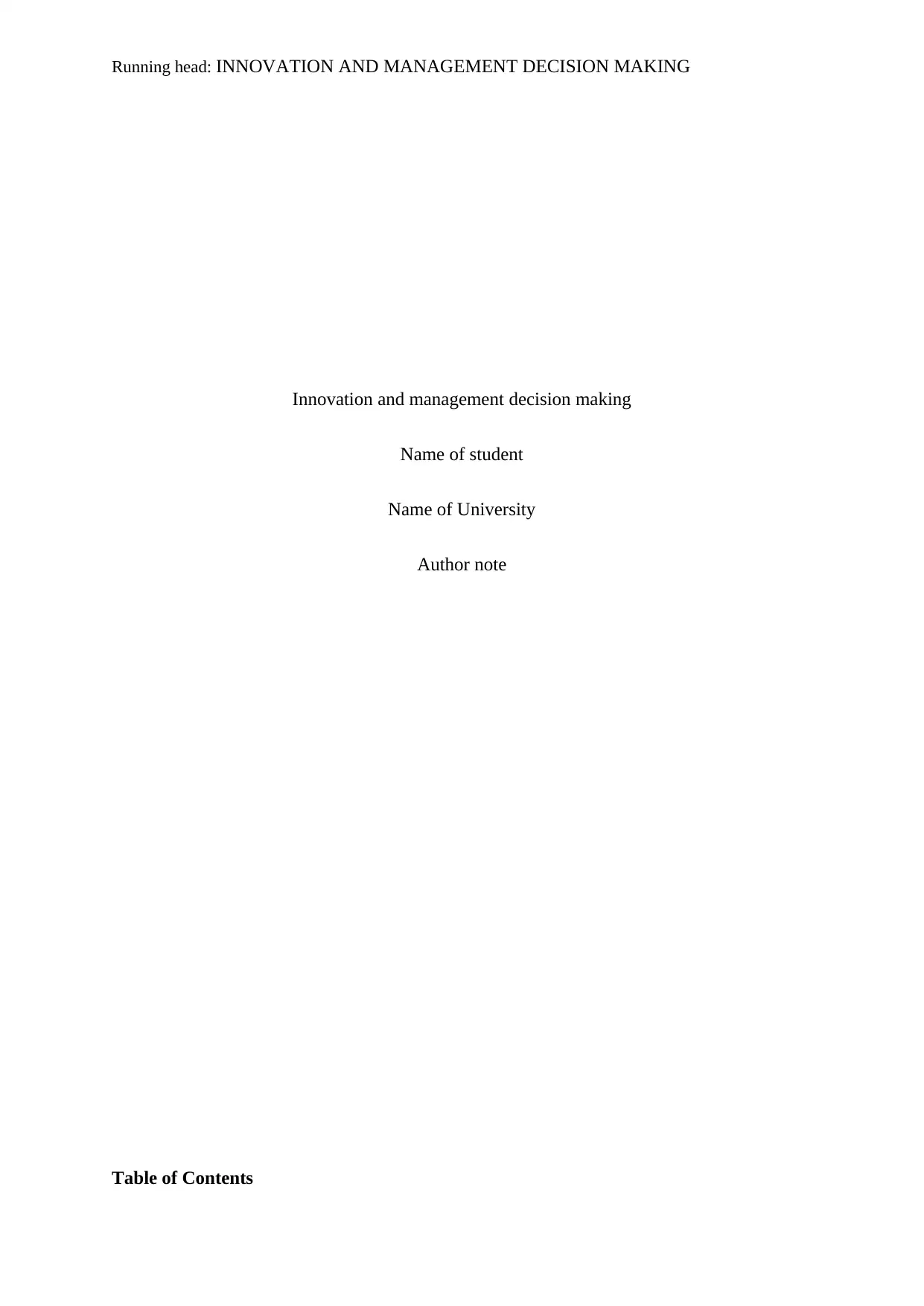
Running head: INNOVATION AND MANAGEMENT DECISION MAKING
Innovation and management decision making
Name of student
Name of University
Author note
Table of Contents
Innovation and management decision making
Name of student
Name of University
Author note
Table of Contents
Secure Best Marks with AI Grader
Need help grading? Try our AI Grader for instant feedback on your assignments.
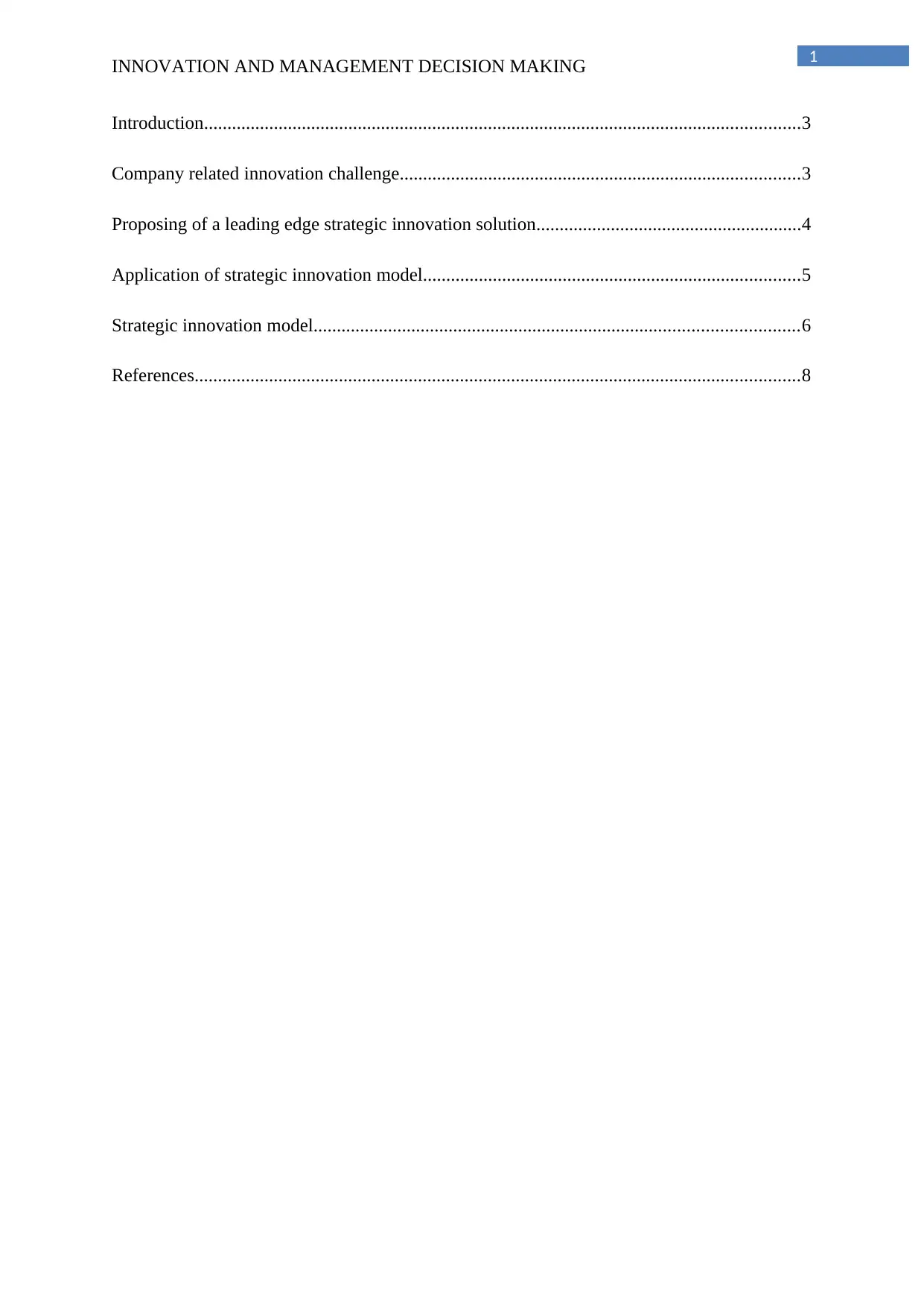
1
INNOVATION AND MANAGEMENT DECISION MAKING
Introduction................................................................................................................................3
Company related innovation challenge......................................................................................3
Proposing of a leading edge strategic innovation solution.........................................................4
Application of strategic innovation model.................................................................................5
Strategic innovation model........................................................................................................6
References..................................................................................................................................8
INNOVATION AND MANAGEMENT DECISION MAKING
Introduction................................................................................................................................3
Company related innovation challenge......................................................................................3
Proposing of a leading edge strategic innovation solution.........................................................4
Application of strategic innovation model.................................................................................5
Strategic innovation model........................................................................................................6
References..................................................................................................................................8
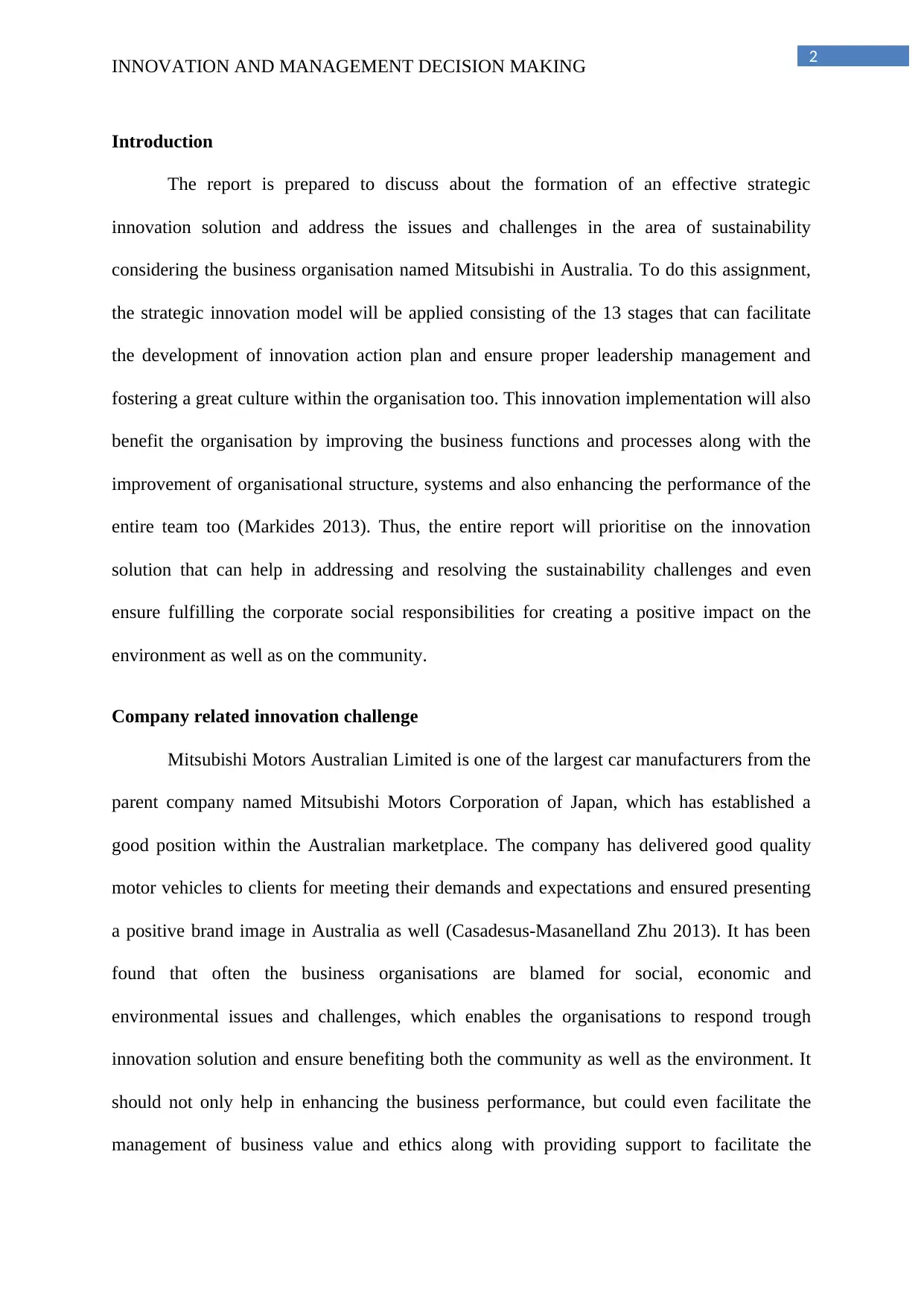
2
INNOVATION AND MANAGEMENT DECISION MAKING
Introduction
The report is prepared to discuss about the formation of an effective strategic
innovation solution and address the issues and challenges in the area of sustainability
considering the business organisation named Mitsubishi in Australia. To do this assignment,
the strategic innovation model will be applied consisting of the 13 stages that can facilitate
the development of innovation action plan and ensure proper leadership management and
fostering a great culture within the organisation too. This innovation implementation will also
benefit the organisation by improving the business functions and processes along with the
improvement of organisational structure, systems and also enhancing the performance of the
entire team too (Markides 2013). Thus, the entire report will prioritise on the innovation
solution that can help in addressing and resolving the sustainability challenges and even
ensure fulfilling the corporate social responsibilities for creating a positive impact on the
environment as well as on the community.
Company related innovation challenge
Mitsubishi Motors Australian Limited is one of the largest car manufacturers from the
parent company named Mitsubishi Motors Corporation of Japan, which has established a
good position within the Australian marketplace. The company has delivered good quality
motor vehicles to clients for meeting their demands and expectations and ensured presenting
a positive brand image in Australia as well (Casadesus‐Masanelland Zhu 2013). It has been
found that often the business organisations are blamed for social, economic and
environmental issues and challenges, which enables the organisations to respond trough
innovation solution and ensure benefiting both the community as well as the environment. It
should not only help in enhancing the business performance, but could even facilitate the
management of business value and ethics along with providing support to facilitate the
INNOVATION AND MANAGEMENT DECISION MAKING
Introduction
The report is prepared to discuss about the formation of an effective strategic
innovation solution and address the issues and challenges in the area of sustainability
considering the business organisation named Mitsubishi in Australia. To do this assignment,
the strategic innovation model will be applied consisting of the 13 stages that can facilitate
the development of innovation action plan and ensure proper leadership management and
fostering a great culture within the organisation too. This innovation implementation will also
benefit the organisation by improving the business functions and processes along with the
improvement of organisational structure, systems and also enhancing the performance of the
entire team too (Markides 2013). Thus, the entire report will prioritise on the innovation
solution that can help in addressing and resolving the sustainability challenges and even
ensure fulfilling the corporate social responsibilities for creating a positive impact on the
environment as well as on the community.
Company related innovation challenge
Mitsubishi Motors Australian Limited is one of the largest car manufacturers from the
parent company named Mitsubishi Motors Corporation of Japan, which has established a
good position within the Australian marketplace. The company has delivered good quality
motor vehicles to clients for meeting their demands and expectations and ensured presenting
a positive brand image in Australia as well (Casadesus‐Masanelland Zhu 2013). It has been
found that often the business organisations are blamed for social, economic and
environmental issues and challenges, which enables the organisations to respond trough
innovation solution and ensure benefiting both the community as well as the environment. It
should not only help in enhancing the business performance, but could even facilitate the
management of business value and ethics along with providing support to facilitate the
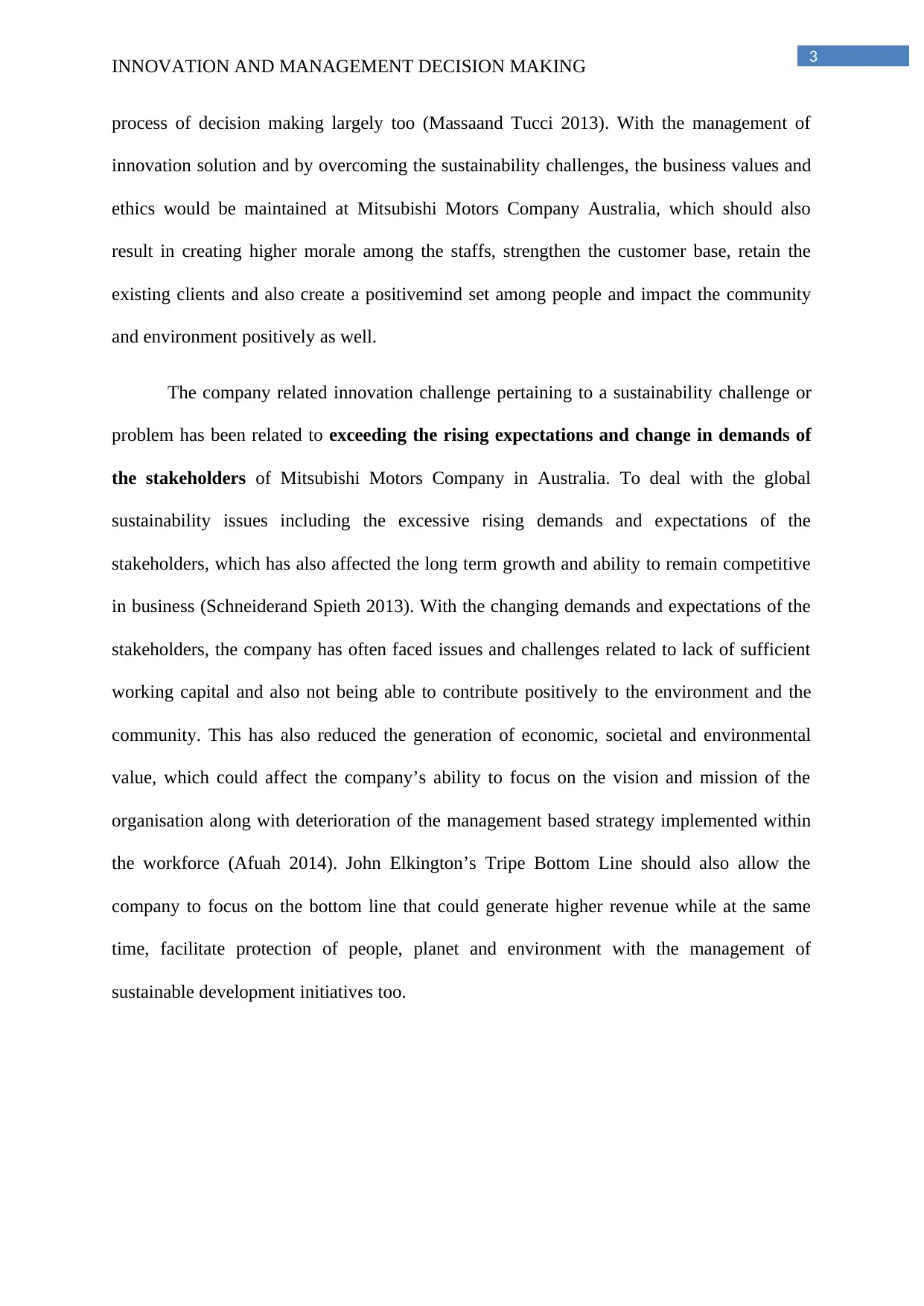
3
INNOVATION AND MANAGEMENT DECISION MAKING
process of decision making largely too (Massaand Tucci 2013). With the management of
innovation solution and by overcoming the sustainability challenges, the business values and
ethics would be maintained at Mitsubishi Motors Company Australia, which should also
result in creating higher morale among the staffs, strengthen the customer base, retain the
existing clients and also create a positivemind set among people and impact the community
and environment positively as well.
The company related innovation challenge pertaining to a sustainability challenge or
problem has been related to exceeding the rising expectations and change in demands of
the stakeholders of Mitsubishi Motors Company in Australia. To deal with the global
sustainability issues including the excessive rising demands and expectations of the
stakeholders, which has also affected the long term growth and ability to remain competitive
in business (Schneiderand Spieth 2013). With the changing demands and expectations of the
stakeholders, the company has often faced issues and challenges related to lack of sufficient
working capital and also not being able to contribute positively to the environment and the
community. This has also reduced the generation of economic, societal and environmental
value, which could affect the company’s ability to focus on the vision and mission of the
organisation along with deterioration of the management based strategy implemented within
the workforce (Afuah 2014). John Elkington’s Tripe Bottom Line should also allow the
company to focus on the bottom line that could generate higher revenue while at the same
time, facilitate protection of people, planet and environment with the management of
sustainable development initiatives too.
INNOVATION AND MANAGEMENT DECISION MAKING
process of decision making largely too (Massaand Tucci 2013). With the management of
innovation solution and by overcoming the sustainability challenges, the business values and
ethics would be maintained at Mitsubishi Motors Company Australia, which should also
result in creating higher morale among the staffs, strengthen the customer base, retain the
existing clients and also create a positivemind set among people and impact the community
and environment positively as well.
The company related innovation challenge pertaining to a sustainability challenge or
problem has been related to exceeding the rising expectations and change in demands of
the stakeholders of Mitsubishi Motors Company in Australia. To deal with the global
sustainability issues including the excessive rising demands and expectations of the
stakeholders, which has also affected the long term growth and ability to remain competitive
in business (Schneiderand Spieth 2013). With the changing demands and expectations of the
stakeholders, the company has often faced issues and challenges related to lack of sufficient
working capital and also not being able to contribute positively to the environment and the
community. This has also reduced the generation of economic, societal and environmental
value, which could affect the company’s ability to focus on the vision and mission of the
organisation along with deterioration of the management based strategy implemented within
the workforce (Afuah 2014). John Elkington’s Tripe Bottom Line should also allow the
company to focus on the bottom line that could generate higher revenue while at the same
time, facilitate protection of people, planet and environment with the management of
sustainable development initiatives too.
Secure Best Marks with AI Grader
Need help grading? Try our AI Grader for instant feedback on your assignments.
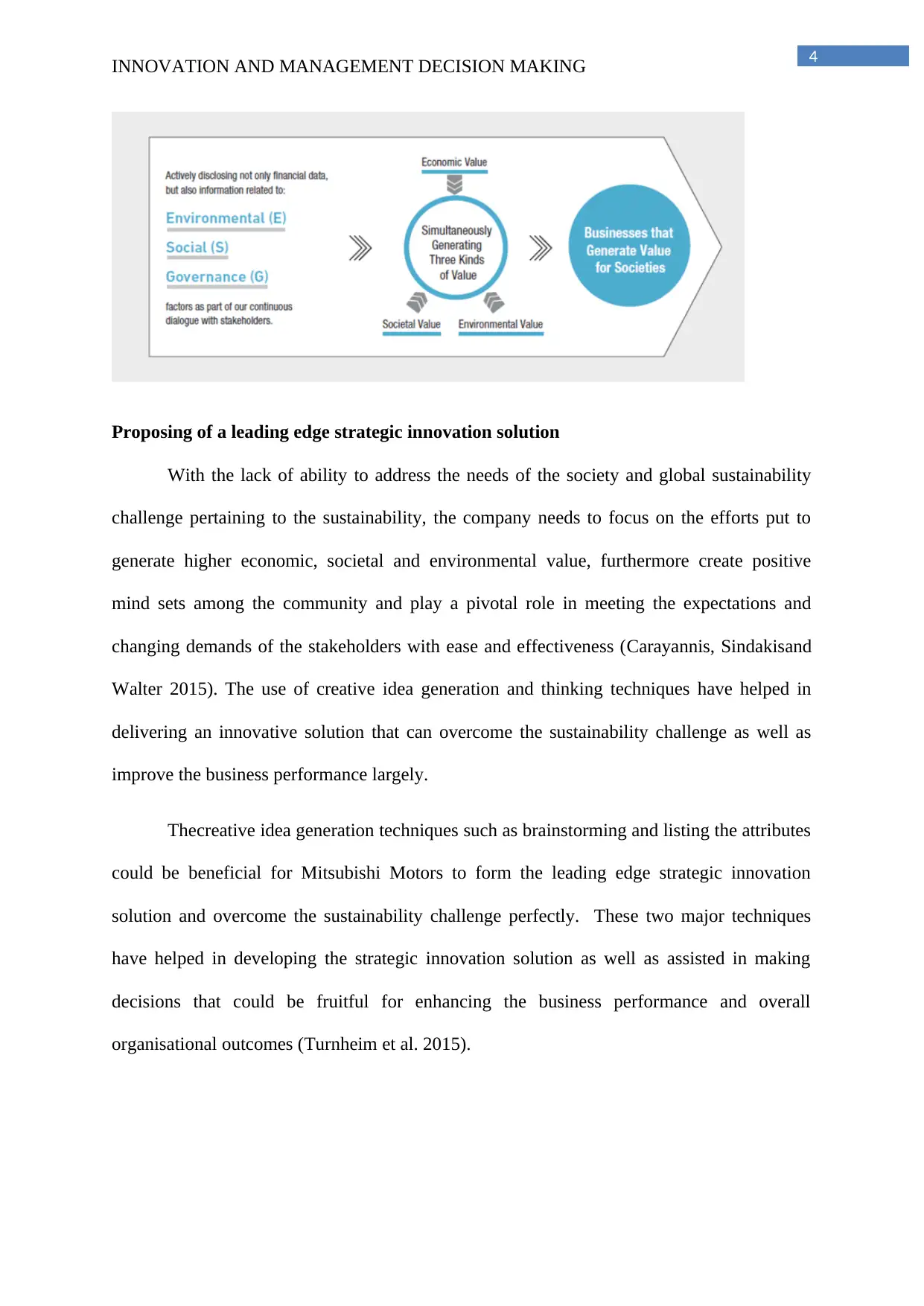
4
INNOVATION AND MANAGEMENT DECISION MAKING
Proposing of a leading edge strategic innovation solution
With the lack of ability to address the needs of the society and global sustainability
challenge pertaining to the sustainability, the company needs to focus on the efforts put to
generate higher economic, societal and environmental value, furthermore create positive
mind sets among the community and play a pivotal role in meeting the expectations and
changing demands of the stakeholders with ease and effectiveness (Carayannis, Sindakisand
Walter 2015). The use of creative idea generation and thinking techniques have helped in
delivering an innovative solution that can overcome the sustainability challenge as well as
improve the business performance largely.
Thecreative idea generation techniques such as brainstorming and listing the attributes
could be beneficial for Mitsubishi Motors to form the leading edge strategic innovation
solution and overcome the sustainability challenge perfectly. These two major techniques
have helped in developing the strategic innovation solution as well as assisted in making
decisions that could be fruitful for enhancing the business performance and overall
organisational outcomes (Turnheim et al. 2015).
INNOVATION AND MANAGEMENT DECISION MAKING
Proposing of a leading edge strategic innovation solution
With the lack of ability to address the needs of the society and global sustainability
challenge pertaining to the sustainability, the company needs to focus on the efforts put to
generate higher economic, societal and environmental value, furthermore create positive
mind sets among the community and play a pivotal role in meeting the expectations and
changing demands of the stakeholders with ease and effectiveness (Carayannis, Sindakisand
Walter 2015). The use of creative idea generation and thinking techniques have helped in
delivering an innovative solution that can overcome the sustainability challenge as well as
improve the business performance largely.
Thecreative idea generation techniques such as brainstorming and listing the attributes
could be beneficial for Mitsubishi Motors to form the leading edge strategic innovation
solution and overcome the sustainability challenge perfectly. These two major techniques
have helped in developing the strategic innovation solution as well as assisted in making
decisions that could be fruitful for enhancing the business performance and overall
organisational outcomes (Turnheim et al. 2015).
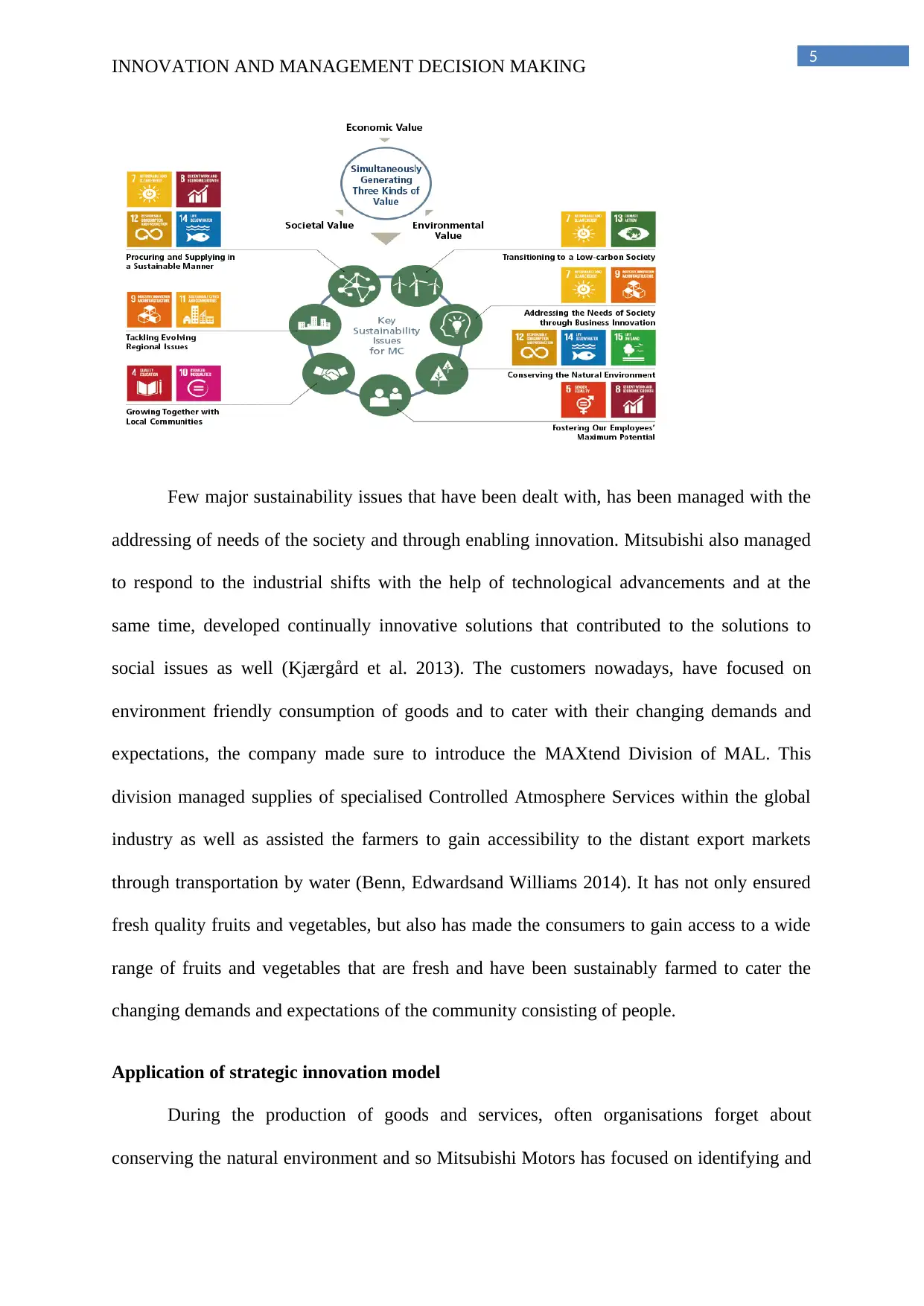
5
INNOVATION AND MANAGEMENT DECISION MAKING
Few major sustainability issues that have been dealt with, has been managed with the
addressing of needs of the society and through enabling innovation. Mitsubishi also managed
to respond to the industrial shifts with the help of technological advancements and at the
same time, developed continually innovative solutions that contributed to the solutions to
social issues as well (Kjӕrgård et al. 2013). The customers nowadays, have focused on
environment friendly consumption of goods and to cater with their changing demands and
expectations, the company made sure to introduce the MAXtend Division of MAL. This
division managed supplies of specialised Controlled Atmosphere Services within the global
industry as well as assisted the farmers to gain accessibility to the distant export markets
through transportation by water (Benn, Edwardsand Williams 2014). It has not only ensured
fresh quality fruits and vegetables, but also has made the consumers to gain access to a wide
range of fruits and vegetables that are fresh and have been sustainably farmed to cater the
changing demands and expectations of the community consisting of people.
Application of strategic innovation model
During the production of goods and services, often organisations forget about
conserving the natural environment and so Mitsubishi Motors has focused on identifying and
INNOVATION AND MANAGEMENT DECISION MAKING
Few major sustainability issues that have been dealt with, has been managed with the
addressing of needs of the society and through enabling innovation. Mitsubishi also managed
to respond to the industrial shifts with the help of technological advancements and at the
same time, developed continually innovative solutions that contributed to the solutions to
social issues as well (Kjӕrgård et al. 2013). The customers nowadays, have focused on
environment friendly consumption of goods and to cater with their changing demands and
expectations, the company made sure to introduce the MAXtend Division of MAL. This
division managed supplies of specialised Controlled Atmosphere Services within the global
industry as well as assisted the farmers to gain accessibility to the distant export markets
through transportation by water (Benn, Edwardsand Williams 2014). It has not only ensured
fresh quality fruits and vegetables, but also has made the consumers to gain access to a wide
range of fruits and vegetables that are fresh and have been sustainably farmed to cater the
changing demands and expectations of the community consisting of people.
Application of strategic innovation model
During the production of goods and services, often organisations forget about
conserving the natural environment and so Mitsubishi Motors has focused on identifying and
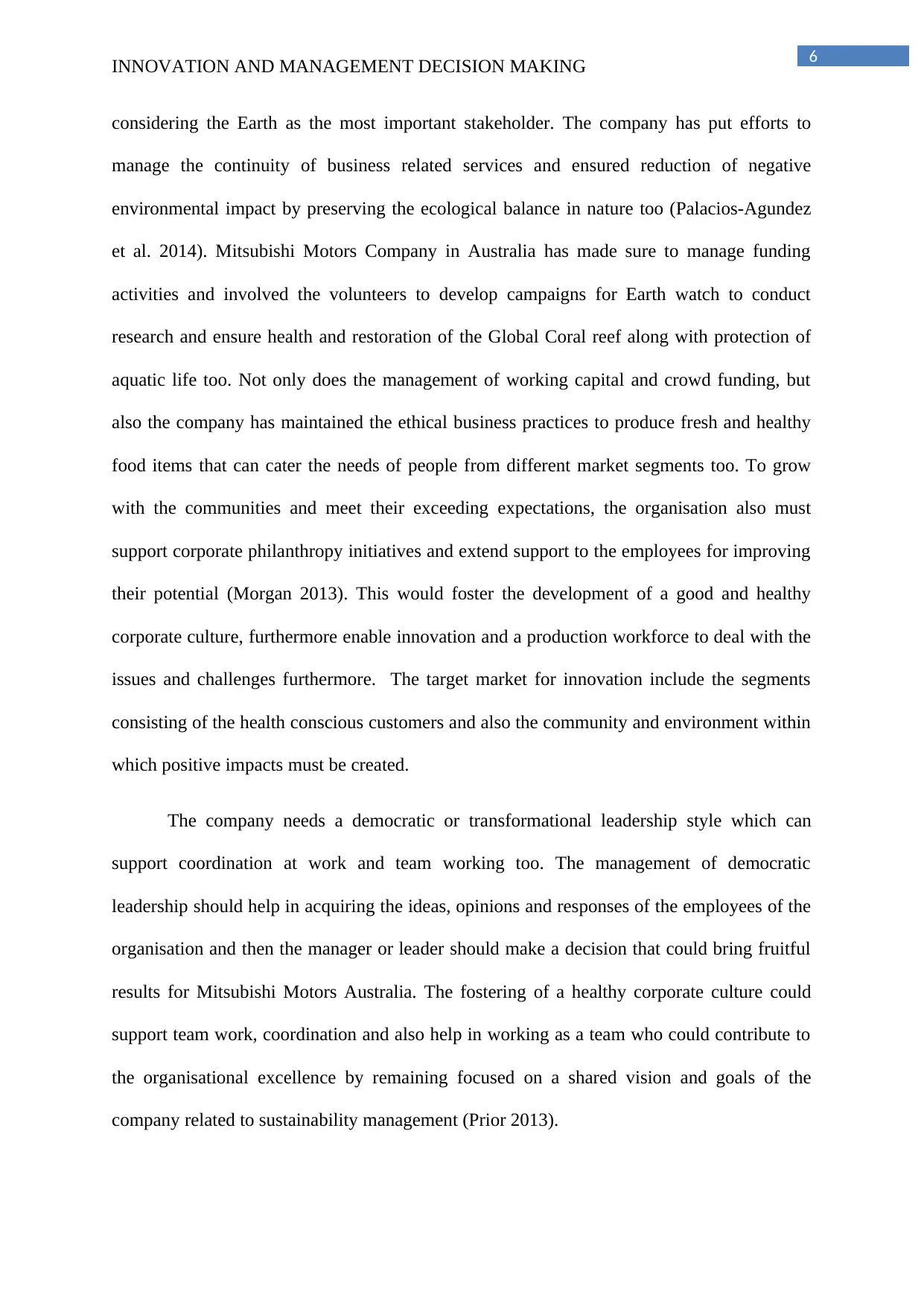
6
INNOVATION AND MANAGEMENT DECISION MAKING
considering the Earth as the most important stakeholder. The company has put efforts to
manage the continuity of business related services and ensured reduction of negative
environmental impact by preserving the ecological balance in nature too (Palacios-Agundez
et al. 2014). Mitsubishi Motors Company in Australia has made sure to manage funding
activities and involved the volunteers to develop campaigns for Earth watch to conduct
research and ensure health and restoration of the Global Coral reef along with protection of
aquatic life too. Not only does the management of working capital and crowd funding, but
also the company has maintained the ethical business practices to produce fresh and healthy
food items that can cater the needs of people from different market segments too. To grow
with the communities and meet their exceeding expectations, the organisation also must
support corporate philanthropy initiatives and extend support to the employees for improving
their potential (Morgan 2013). This would foster the development of a good and healthy
corporate culture, furthermore enable innovation and a production workforce to deal with the
issues and challenges furthermore. The target market for innovation include the segments
consisting of the health conscious customers and also the community and environment within
which positive impacts must be created.
The company needs a democratic or transformational leadership style which can
support coordination at work and team working too. The management of democratic
leadership should help in acquiring the ideas, opinions and responses of the employees of the
organisation and then the manager or leader should make a decision that could bring fruitful
results for Mitsubishi Motors Australia. The fostering of a healthy corporate culture could
support team work, coordination and also help in working as a team who could contribute to
the organisational excellence by remaining focused on a shared vision and goals of the
company related to sustainability management (Prior 2013).
INNOVATION AND MANAGEMENT DECISION MAKING
considering the Earth as the most important stakeholder. The company has put efforts to
manage the continuity of business related services and ensured reduction of negative
environmental impact by preserving the ecological balance in nature too (Palacios-Agundez
et al. 2014). Mitsubishi Motors Company in Australia has made sure to manage funding
activities and involved the volunteers to develop campaigns for Earth watch to conduct
research and ensure health and restoration of the Global Coral reef along with protection of
aquatic life too. Not only does the management of working capital and crowd funding, but
also the company has maintained the ethical business practices to produce fresh and healthy
food items that can cater the needs of people from different market segments too. To grow
with the communities and meet their exceeding expectations, the organisation also must
support corporate philanthropy initiatives and extend support to the employees for improving
their potential (Morgan 2013). This would foster the development of a good and healthy
corporate culture, furthermore enable innovation and a production workforce to deal with the
issues and challenges furthermore. The target market for innovation include the segments
consisting of the health conscious customers and also the community and environment within
which positive impacts must be created.
The company needs a democratic or transformational leadership style which can
support coordination at work and team working too. The management of democratic
leadership should help in acquiring the ideas, opinions and responses of the employees of the
organisation and then the manager or leader should make a decision that could bring fruitful
results for Mitsubishi Motors Australia. The fostering of a healthy corporate culture could
support team work, coordination and also help in working as a team who could contribute to
the organisational excellence by remaining focused on a shared vision and goals of the
company related to sustainability management (Prior 2013).
Paraphrase This Document
Need a fresh take? Get an instant paraphrase of this document with our AI Paraphraser
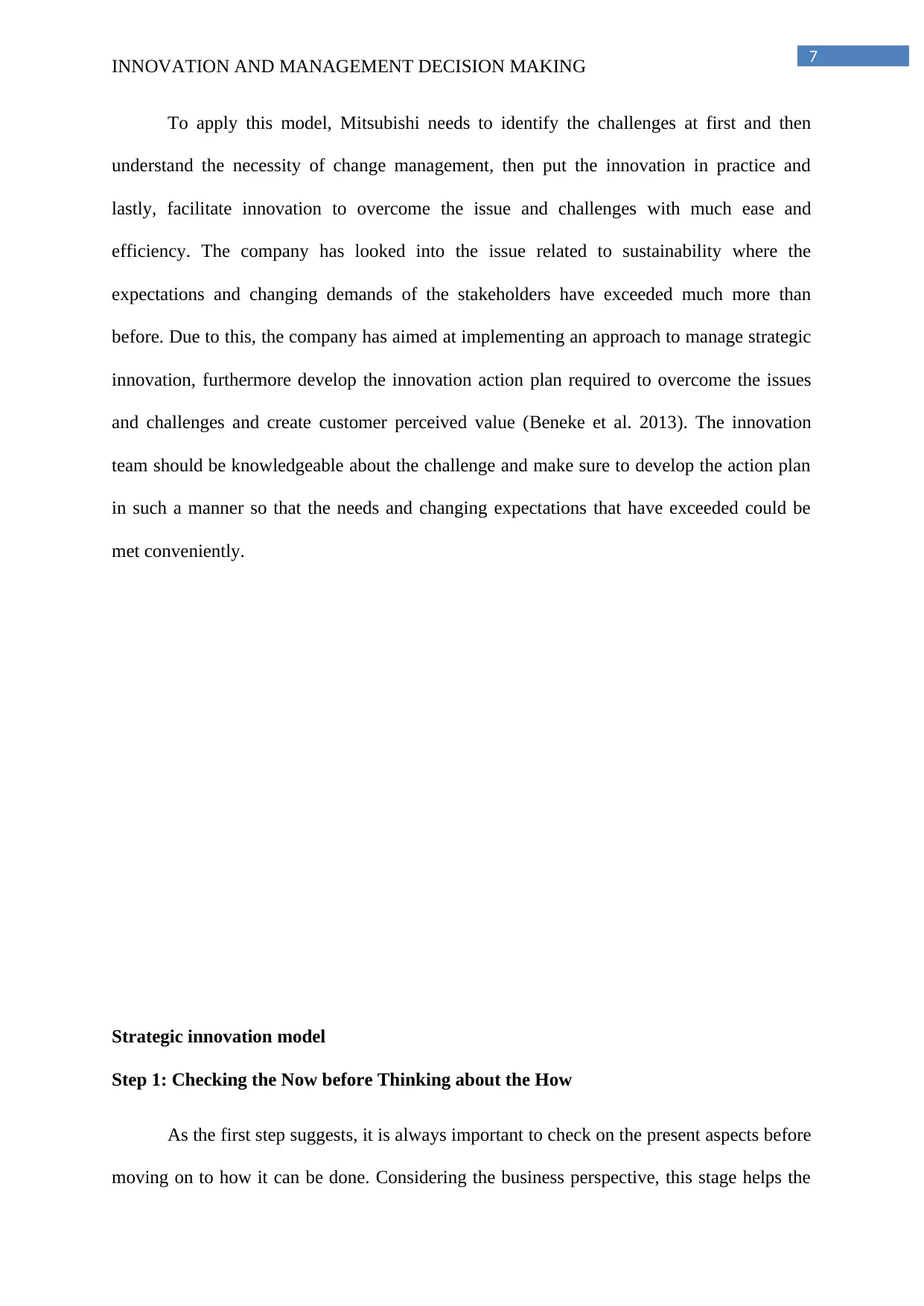
7
INNOVATION AND MANAGEMENT DECISION MAKING
To apply this model, Mitsubishi needs to identify the challenges at first and then
understand the necessity of change management, then put the innovation in practice and
lastly, facilitate innovation to overcome the issue and challenges with much ease and
efficiency. The company has looked into the issue related to sustainability where the
expectations and changing demands of the stakeholders have exceeded much more than
before. Due to this, the company has aimed at implementing an approach to manage strategic
innovation, furthermore develop the innovation action plan required to overcome the issues
and challenges and create customer perceived value (Beneke et al. 2013). The innovation
team should be knowledgeable about the challenge and make sure to develop the action plan
in such a manner so that the needs and changing expectations that have exceeded could be
met conveniently.
Strategic innovation model
Step 1: Checking the Now before Thinking about the How
As the first step suggests, it is always important to check on the present aspects before
moving on to how it can be done. Considering the business perspective, this stage helps the
INNOVATION AND MANAGEMENT DECISION MAKING
To apply this model, Mitsubishi needs to identify the challenges at first and then
understand the necessity of change management, then put the innovation in practice and
lastly, facilitate innovation to overcome the issue and challenges with much ease and
efficiency. The company has looked into the issue related to sustainability where the
expectations and changing demands of the stakeholders have exceeded much more than
before. Due to this, the company has aimed at implementing an approach to manage strategic
innovation, furthermore develop the innovation action plan required to overcome the issues
and challenges and create customer perceived value (Beneke et al. 2013). The innovation
team should be knowledgeable about the challenge and make sure to develop the action plan
in such a manner so that the needs and changing expectations that have exceeded could be
met conveniently.
Strategic innovation model
Step 1: Checking the Now before Thinking about the How
As the first step suggests, it is always important to check on the present aspects before
moving on to how it can be done. Considering the business perspective, this stage helps the
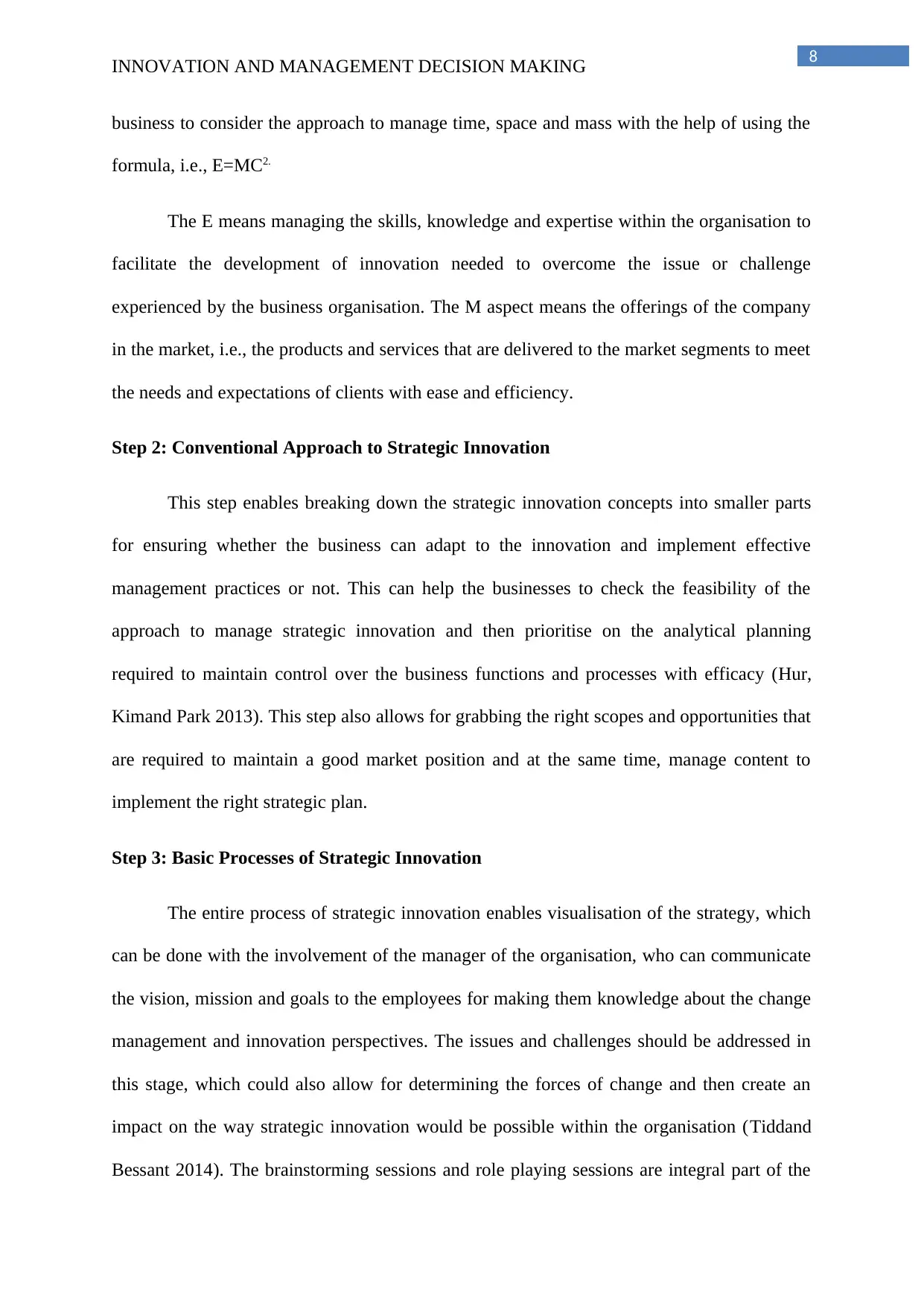
8
INNOVATION AND MANAGEMENT DECISION MAKING
business to consider the approach to manage time, space and mass with the help of using the
formula, i.e., E=MC2.
The E means managing the skills, knowledge and expertise within the organisation to
facilitate the development of innovation needed to overcome the issue or challenge
experienced by the business organisation. The M aspect means the offerings of the company
in the market, i.e., the products and services that are delivered to the market segments to meet
the needs and expectations of clients with ease and efficiency.
Step 2: Conventional Approach to Strategic Innovation
This step enables breaking down the strategic innovation concepts into smaller parts
for ensuring whether the business can adapt to the innovation and implement effective
management practices or not. This can help the businesses to check the feasibility of the
approach to manage strategic innovation and then prioritise on the analytical planning
required to maintain control over the business functions and processes with efficacy (Hur,
Kimand Park 2013). This step also allows for grabbing the right scopes and opportunities that
are required to maintain a good market position and at the same time, manage content to
implement the right strategic plan.
Step 3: Basic Processes of Strategic Innovation
The entire process of strategic innovation enables visualisation of the strategy, which
can be done with the involvement of the manager of the organisation, who can communicate
the vision, mission and goals to the employees for making them knowledge about the change
management and innovation perspectives. The issues and challenges should be addressed in
this stage, which could also allow for determining the forces of change and then create an
impact on the way strategic innovation would be possible within the organisation (Tiddand
Bessant 2014). The brainstorming sessions and role playing sessions are integral part of the
INNOVATION AND MANAGEMENT DECISION MAKING
business to consider the approach to manage time, space and mass with the help of using the
formula, i.e., E=MC2.
The E means managing the skills, knowledge and expertise within the organisation to
facilitate the development of innovation needed to overcome the issue or challenge
experienced by the business organisation. The M aspect means the offerings of the company
in the market, i.e., the products and services that are delivered to the market segments to meet
the needs and expectations of clients with ease and efficiency.
Step 2: Conventional Approach to Strategic Innovation
This step enables breaking down the strategic innovation concepts into smaller parts
for ensuring whether the business can adapt to the innovation and implement effective
management practices or not. This can help the businesses to check the feasibility of the
approach to manage strategic innovation and then prioritise on the analytical planning
required to maintain control over the business functions and processes with efficacy (Hur,
Kimand Park 2013). This step also allows for grabbing the right scopes and opportunities that
are required to maintain a good market position and at the same time, manage content to
implement the right strategic plan.
Step 3: Basic Processes of Strategic Innovation
The entire process of strategic innovation enables visualisation of the strategy, which
can be done with the involvement of the manager of the organisation, who can communicate
the vision, mission and goals to the employees for making them knowledge about the change
management and innovation perspectives. The issues and challenges should be addressed in
this stage, which could also allow for determining the forces of change and then create an
impact on the way strategic innovation would be possible within the organisation (Tiddand
Bessant 2014). The brainstorming sessions and role playing sessions are integral part of the
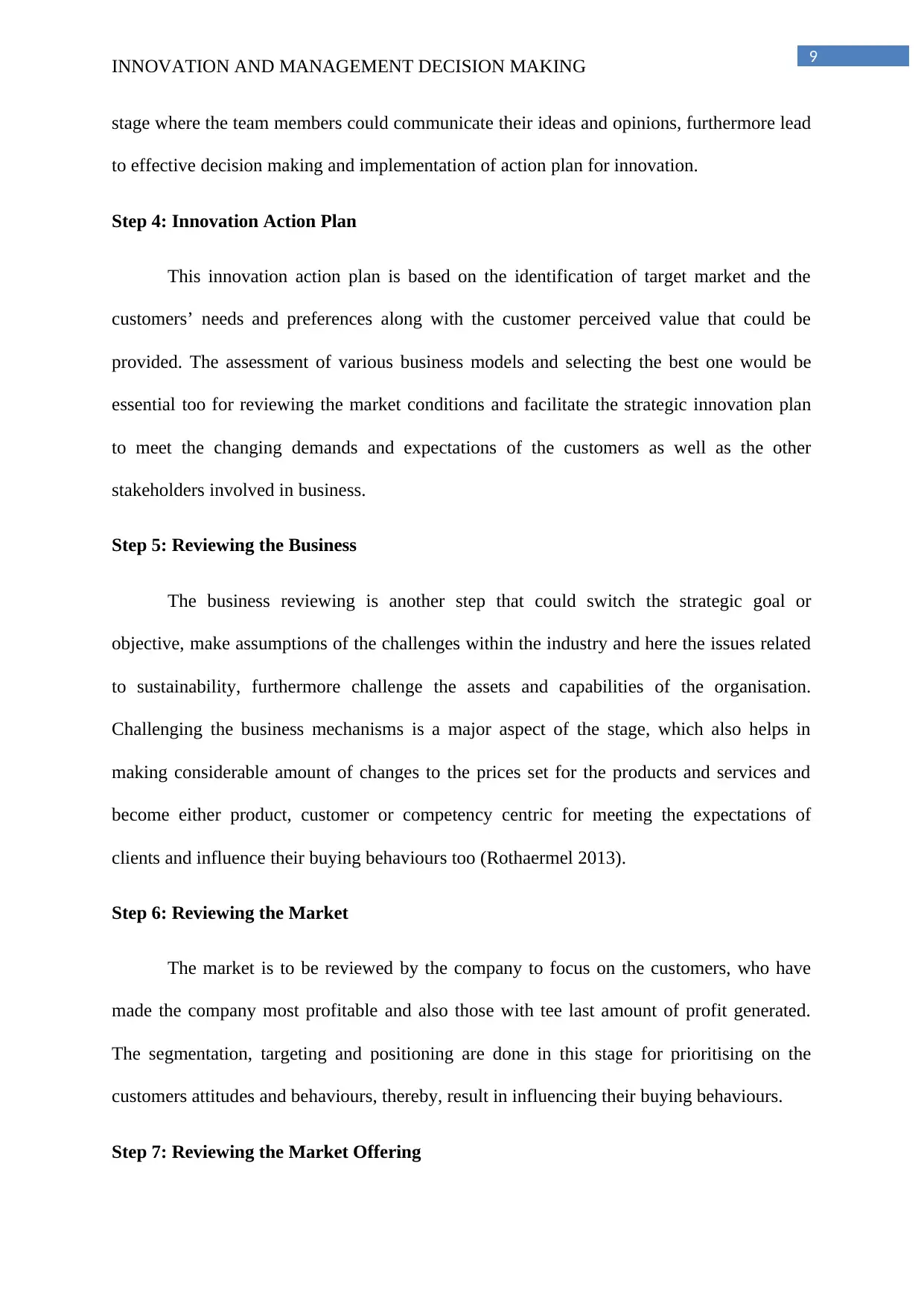
9
INNOVATION AND MANAGEMENT DECISION MAKING
stage where the team members could communicate their ideas and opinions, furthermore lead
to effective decision making and implementation of action plan for innovation.
Step 4: Innovation Action Plan
This innovation action plan is based on the identification of target market and the
customers’ needs and preferences along with the customer perceived value that could be
provided. The assessment of various business models and selecting the best one would be
essential too for reviewing the market conditions and facilitate the strategic innovation plan
to meet the changing demands and expectations of the customers as well as the other
stakeholders involved in business.
Step 5: Reviewing the Business
The business reviewing is another step that could switch the strategic goal or
objective, make assumptions of the challenges within the industry and here the issues related
to sustainability, furthermore challenge the assets and capabilities of the organisation.
Challenging the business mechanisms is a major aspect of the stage, which also helps in
making considerable amount of changes to the prices set for the products and services and
become either product, customer or competency centric for meeting the expectations of
clients and influence their buying behaviours too (Rothaermel 2013).
Step 6: Reviewing the Market
The market is to be reviewed by the company to focus on the customers, who have
made the company most profitable and also those with tee last amount of profit generated.
The segmentation, targeting and positioning are done in this stage for prioritising on the
customers attitudes and behaviours, thereby, result in influencing their buying behaviours.
Step 7: Reviewing the Market Offering
INNOVATION AND MANAGEMENT DECISION MAKING
stage where the team members could communicate their ideas and opinions, furthermore lead
to effective decision making and implementation of action plan for innovation.
Step 4: Innovation Action Plan
This innovation action plan is based on the identification of target market and the
customers’ needs and preferences along with the customer perceived value that could be
provided. The assessment of various business models and selecting the best one would be
essential too for reviewing the market conditions and facilitate the strategic innovation plan
to meet the changing demands and expectations of the customers as well as the other
stakeholders involved in business.
Step 5: Reviewing the Business
The business reviewing is another step that could switch the strategic goal or
objective, make assumptions of the challenges within the industry and here the issues related
to sustainability, furthermore challenge the assets and capabilities of the organisation.
Challenging the business mechanisms is a major aspect of the stage, which also helps in
making considerable amount of changes to the prices set for the products and services and
become either product, customer or competency centric for meeting the expectations of
clients and influence their buying behaviours too (Rothaermel 2013).
Step 6: Reviewing the Market
The market is to be reviewed by the company to focus on the customers, who have
made the company most profitable and also those with tee last amount of profit generated.
The segmentation, targeting and positioning are done in this stage for prioritising on the
customers attitudes and behaviours, thereby, result in influencing their buying behaviours.
Step 7: Reviewing the Market Offering
Secure Best Marks with AI Grader
Need help grading? Try our AI Grader for instant feedback on your assignments.
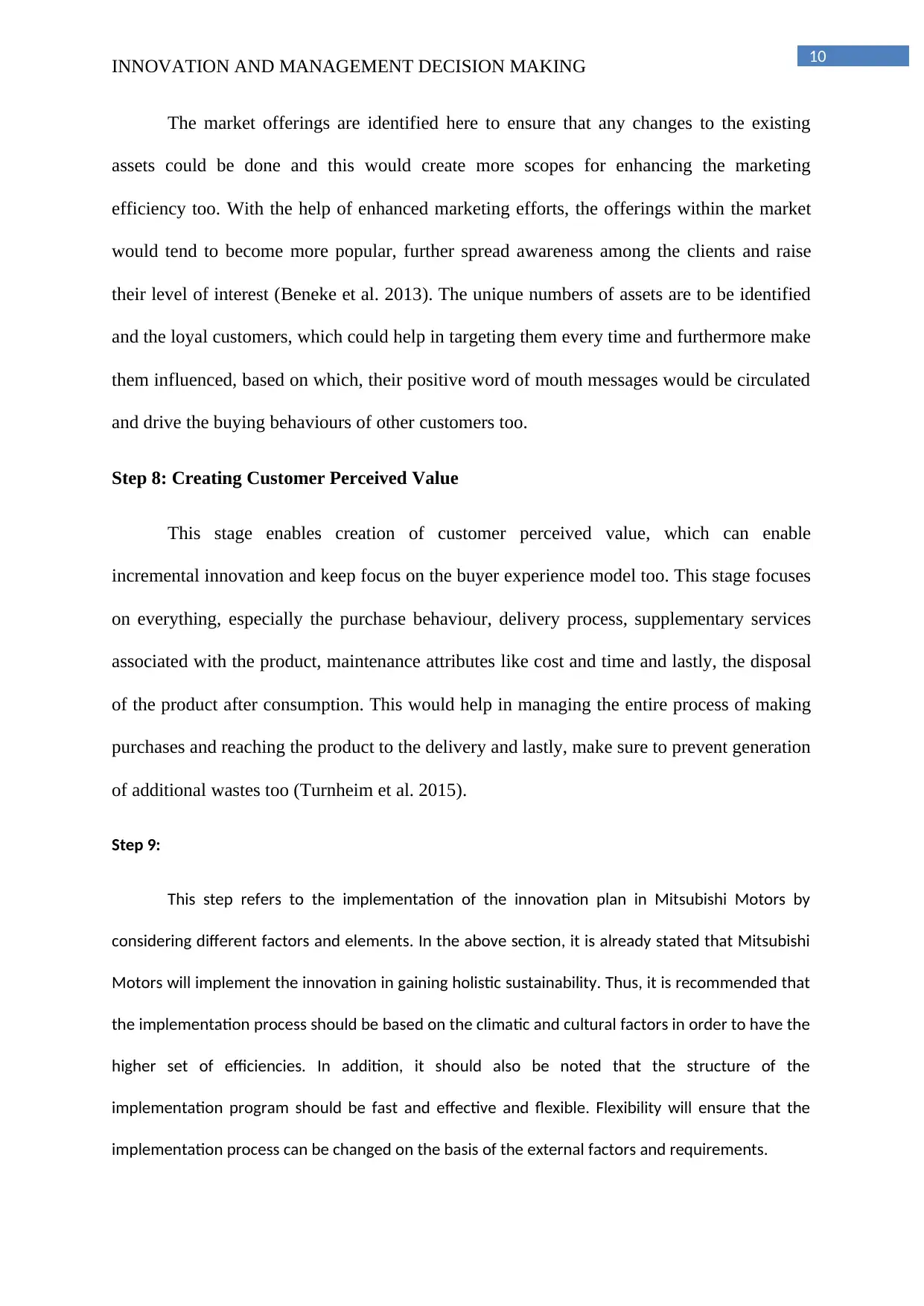
10
INNOVATION AND MANAGEMENT DECISION MAKING
The market offerings are identified here to ensure that any changes to the existing
assets could be done and this would create more scopes for enhancing the marketing
efficiency too. With the help of enhanced marketing efforts, the offerings within the market
would tend to become more popular, further spread awareness among the clients and raise
their level of interest (Beneke et al. 2013). The unique numbers of assets are to be identified
and the loyal customers, which could help in targeting them every time and furthermore make
them influenced, based on which, their positive word of mouth messages would be circulated
and drive the buying behaviours of other customers too.
Step 8: Creating Customer Perceived Value
This stage enables creation of customer perceived value, which can enable
incremental innovation and keep focus on the buyer experience model too. This stage focuses
on everything, especially the purchase behaviour, delivery process, supplementary services
associated with the product, maintenance attributes like cost and time and lastly, the disposal
of the product after consumption. This would help in managing the entire process of making
purchases and reaching the product to the delivery and lastly, make sure to prevent generation
of additional wastes too (Turnheim et al. 2015).
Step 9:
This step refers to the implementation of the innovation plan in Mitsubishi Motors by
considering different factors and elements. In the above section, it is already stated that Mitsubishi
Motors will implement the innovation in gaining holistic sustainability. Thus, it is recommended that
the implementation process should be based on the climatic and cultural factors in order to have the
higher set of efficiencies. In addition, it should also be noted that the structure of the
implementation program should be fast and effective and flexible. Flexibility will ensure that the
implementation process can be changed on the basis of the external factors and requirements.
INNOVATION AND MANAGEMENT DECISION MAKING
The market offerings are identified here to ensure that any changes to the existing
assets could be done and this would create more scopes for enhancing the marketing
efficiency too. With the help of enhanced marketing efforts, the offerings within the market
would tend to become more popular, further spread awareness among the clients and raise
their level of interest (Beneke et al. 2013). The unique numbers of assets are to be identified
and the loyal customers, which could help in targeting them every time and furthermore make
them influenced, based on which, their positive word of mouth messages would be circulated
and drive the buying behaviours of other customers too.
Step 8: Creating Customer Perceived Value
This stage enables creation of customer perceived value, which can enable
incremental innovation and keep focus on the buyer experience model too. This stage focuses
on everything, especially the purchase behaviour, delivery process, supplementary services
associated with the product, maintenance attributes like cost and time and lastly, the disposal
of the product after consumption. This would help in managing the entire process of making
purchases and reaching the product to the delivery and lastly, make sure to prevent generation
of additional wastes too (Turnheim et al. 2015).
Step 9:
This step refers to the implementation of the innovation plan in Mitsubishi Motors by
considering different factors and elements. In the above section, it is already stated that Mitsubishi
Motors will implement the innovation in gaining holistic sustainability. Thus, it is recommended that
the implementation process should be based on the climatic and cultural factors in order to have the
higher set of efficiencies. In addition, it should also be noted that the structure of the
implementation program should be fast and effective and flexible. Flexibility will ensure that the
implementation process can be changed on the basis of the external factors and requirements.
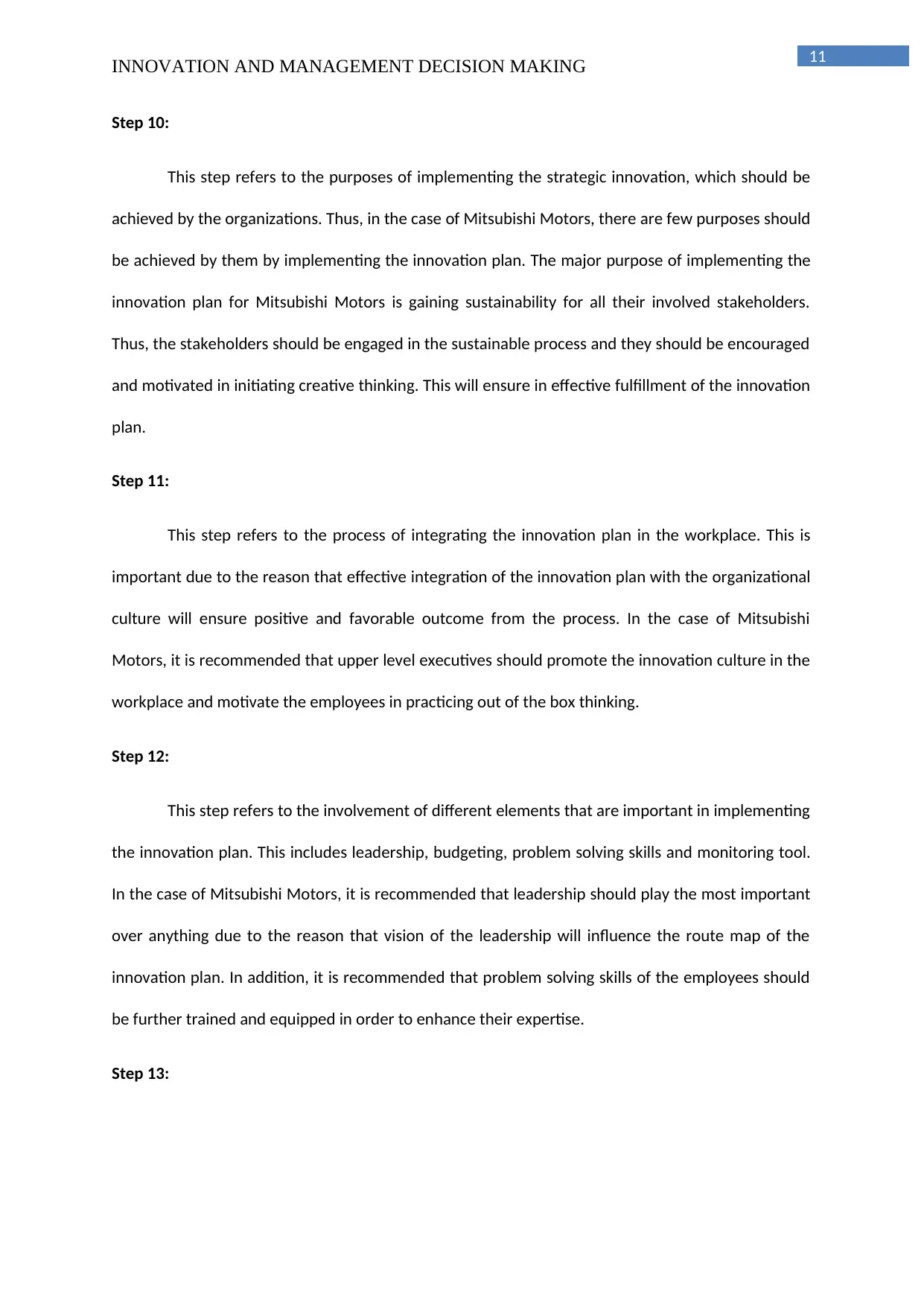
11
INNOVATION AND MANAGEMENT DECISION MAKING
Step 10:
This step refers to the purposes of implementing the strategic innovation, which should be
achieved by the organizations. Thus, in the case of Mitsubishi Motors, there are few purposes should
be achieved by them by implementing the innovation plan. The major purpose of implementing the
innovation plan for Mitsubishi Motors is gaining sustainability for all their involved stakeholders.
Thus, the stakeholders should be engaged in the sustainable process and they should be encouraged
and motivated in initiating creative thinking. This will ensure in effective fulfillment of the innovation
plan.
Step 11:
This step refers to the process of integrating the innovation plan in the workplace. This is
important due to the reason that effective integration of the innovation plan with the organizational
culture will ensure positive and favorable outcome from the process. In the case of Mitsubishi
Motors, it is recommended that upper level executives should promote the innovation culture in the
workplace and motivate the employees in practicing out of the box thinking.
Step 12:
This step refers to the involvement of different elements that are important in implementing
the innovation plan. This includes leadership, budgeting, problem solving skills and monitoring tool.
In the case of Mitsubishi Motors, it is recommended that leadership should play the most important
over anything due to the reason that vision of the leadership will influence the route map of the
innovation plan. In addition, it is recommended that problem solving skills of the employees should
be further trained and equipped in order to enhance their expertise.
Step 13:
INNOVATION AND MANAGEMENT DECISION MAKING
Step 10:
This step refers to the purposes of implementing the strategic innovation, which should be
achieved by the organizations. Thus, in the case of Mitsubishi Motors, there are few purposes should
be achieved by them by implementing the innovation plan. The major purpose of implementing the
innovation plan for Mitsubishi Motors is gaining sustainability for all their involved stakeholders.
Thus, the stakeholders should be engaged in the sustainable process and they should be encouraged
and motivated in initiating creative thinking. This will ensure in effective fulfillment of the innovation
plan.
Step 11:
This step refers to the process of integrating the innovation plan in the workplace. This is
important due to the reason that effective integration of the innovation plan with the organizational
culture will ensure positive and favorable outcome from the process. In the case of Mitsubishi
Motors, it is recommended that upper level executives should promote the innovation culture in the
workplace and motivate the employees in practicing out of the box thinking.
Step 12:
This step refers to the involvement of different elements that are important in implementing
the innovation plan. This includes leadership, budgeting, problem solving skills and monitoring tool.
In the case of Mitsubishi Motors, it is recommended that leadership should play the most important
over anything due to the reason that vision of the leadership will influence the route map of the
innovation plan. In addition, it is recommended that problem solving skills of the employees should
be further trained and equipped in order to enhance their expertise.
Step 13:
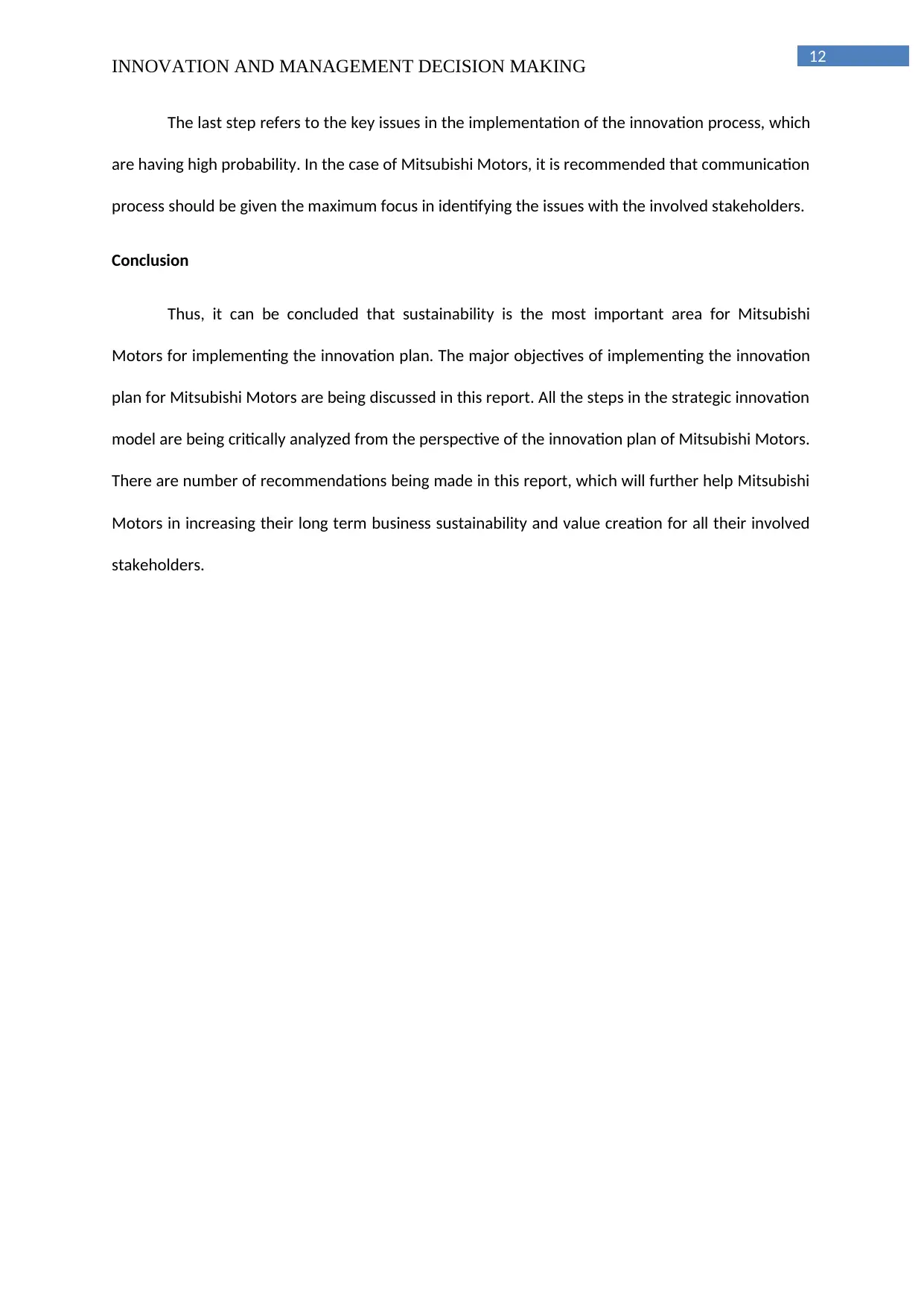
12
INNOVATION AND MANAGEMENT DECISION MAKING
The last step refers to the key issues in the implementation of the innovation process, which
are having high probability. In the case of Mitsubishi Motors, it is recommended that communication
process should be given the maximum focus in identifying the issues with the involved stakeholders.
Conclusion
Thus, it can be concluded that sustainability is the most important area for Mitsubishi
Motors for implementing the innovation plan. The major objectives of implementing the innovation
plan for Mitsubishi Motors are being discussed in this report. All the steps in the strategic innovation
model are being critically analyzed from the perspective of the innovation plan of Mitsubishi Motors.
There are number of recommendations being made in this report, which will further help Mitsubishi
Motors in increasing their long term business sustainability and value creation for all their involved
stakeholders.
INNOVATION AND MANAGEMENT DECISION MAKING
The last step refers to the key issues in the implementation of the innovation process, which
are having high probability. In the case of Mitsubishi Motors, it is recommended that communication
process should be given the maximum focus in identifying the issues with the involved stakeholders.
Conclusion
Thus, it can be concluded that sustainability is the most important area for Mitsubishi
Motors for implementing the innovation plan. The major objectives of implementing the innovation
plan for Mitsubishi Motors are being discussed in this report. All the steps in the strategic innovation
model are being critically analyzed from the perspective of the innovation plan of Mitsubishi Motors.
There are number of recommendations being made in this report, which will further help Mitsubishi
Motors in increasing their long term business sustainability and value creation for all their involved
stakeholders.
Paraphrase This Document
Need a fresh take? Get an instant paraphrase of this document with our AI Paraphraser
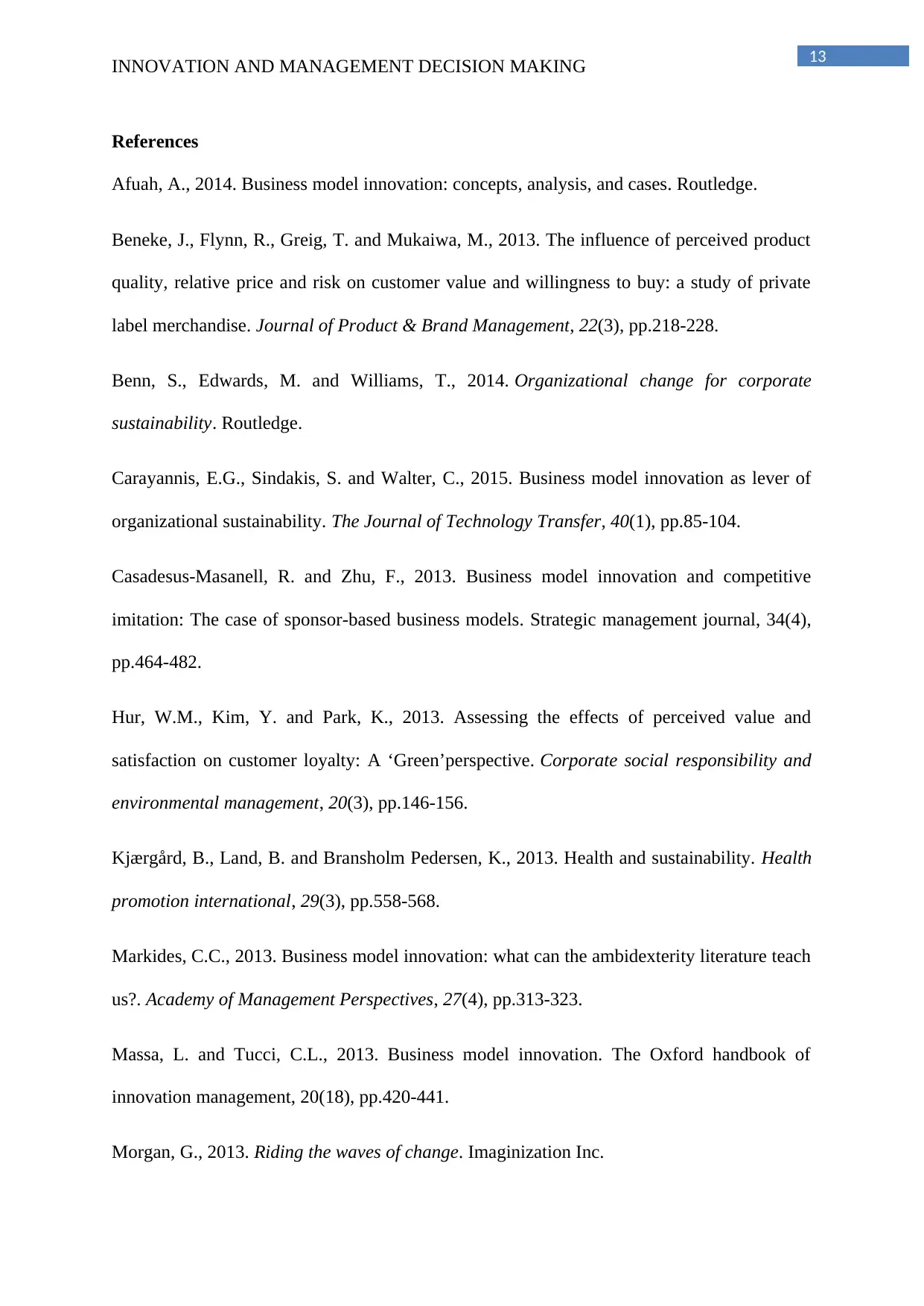
13
INNOVATION AND MANAGEMENT DECISION MAKING
References
Afuah, A., 2014. Business model innovation: concepts, analysis, and cases. Routledge.
Beneke, J., Flynn, R., Greig, T. and Mukaiwa, M., 2013. The influence of perceived product
quality, relative price and risk on customer value and willingness to buy: a study of private
label merchandise. Journal of Product & Brand Management, 22(3), pp.218-228.
Benn, S., Edwards, M. and Williams, T., 2014. Organizational change for corporate
sustainability. Routledge.
Carayannis, E.G., Sindakis, S. and Walter, C., 2015. Business model innovation as lever of
organizational sustainability. The Journal of Technology Transfer, 40(1), pp.85-104.
Casadesus‐Masanell, R. and Zhu, F., 2013. Business model innovation and competitive
imitation: The case of sponsor‐based business models. Strategic management journal, 34(4),
pp.464-482.
Hur, W.M., Kim, Y. and Park, K., 2013. Assessing the effects of perceived value and
satisfaction on customer loyalty: A ‘Green’perspective. Corporate social responsibility and
environmental management, 20(3), pp.146-156.
Kjӕrgård, B., Land, B. and Bransholm Pedersen, K., 2013. Health and sustainability. Health
promotion international, 29(3), pp.558-568.
Markides, C.C., 2013. Business model innovation: what can the ambidexterity literature teach
us?. Academy of Management Perspectives, 27(4), pp.313-323.
Massa, L. and Tucci, C.L., 2013. Business model innovation. The Oxford handbook of
innovation management, 20(18), pp.420-441.
Morgan, G., 2013. Riding the waves of change. Imaginization Inc.
INNOVATION AND MANAGEMENT DECISION MAKING
References
Afuah, A., 2014. Business model innovation: concepts, analysis, and cases. Routledge.
Beneke, J., Flynn, R., Greig, T. and Mukaiwa, M., 2013. The influence of perceived product
quality, relative price and risk on customer value and willingness to buy: a study of private
label merchandise. Journal of Product & Brand Management, 22(3), pp.218-228.
Benn, S., Edwards, M. and Williams, T., 2014. Organizational change for corporate
sustainability. Routledge.
Carayannis, E.G., Sindakis, S. and Walter, C., 2015. Business model innovation as lever of
organizational sustainability. The Journal of Technology Transfer, 40(1), pp.85-104.
Casadesus‐Masanell, R. and Zhu, F., 2013. Business model innovation and competitive
imitation: The case of sponsor‐based business models. Strategic management journal, 34(4),
pp.464-482.
Hur, W.M., Kim, Y. and Park, K., 2013. Assessing the effects of perceived value and
satisfaction on customer loyalty: A ‘Green’perspective. Corporate social responsibility and
environmental management, 20(3), pp.146-156.
Kjӕrgård, B., Land, B. and Bransholm Pedersen, K., 2013. Health and sustainability. Health
promotion international, 29(3), pp.558-568.
Markides, C.C., 2013. Business model innovation: what can the ambidexterity literature teach
us?. Academy of Management Perspectives, 27(4), pp.313-323.
Massa, L. and Tucci, C.L., 2013. Business model innovation. The Oxford handbook of
innovation management, 20(18), pp.420-441.
Morgan, G., 2013. Riding the waves of change. Imaginization Inc.
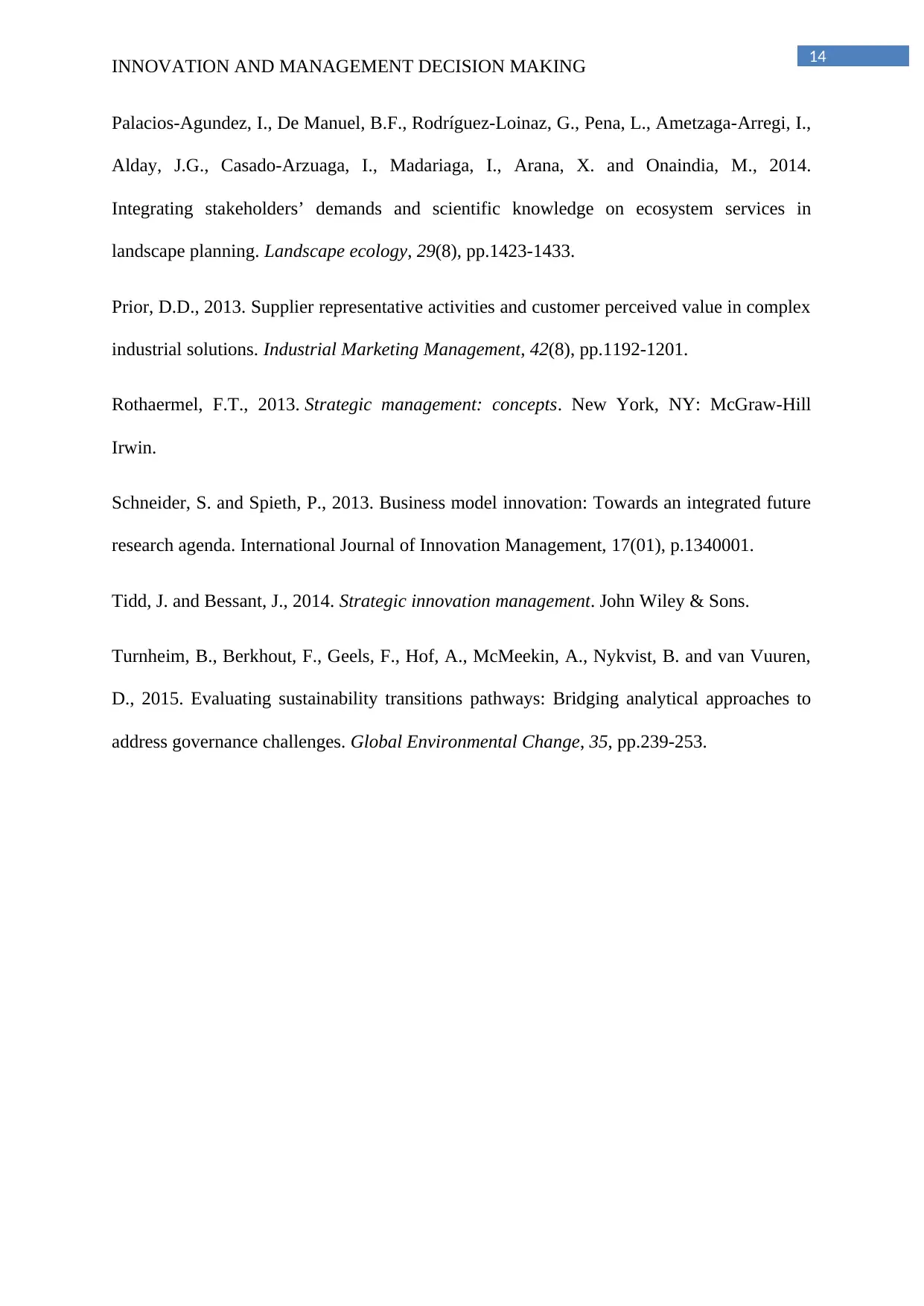
14
INNOVATION AND MANAGEMENT DECISION MAKING
Palacios-Agundez, I., De Manuel, B.F., Rodríguez-Loinaz, G., Pena, L., Ametzaga-Arregi, I.,
Alday, J.G., Casado-Arzuaga, I., Madariaga, I., Arana, X. and Onaindia, M., 2014.
Integrating stakeholders’ demands and scientific knowledge on ecosystem services in
landscape planning. Landscape ecology, 29(8), pp.1423-1433.
Prior, D.D., 2013. Supplier representative activities and customer perceived value in complex
industrial solutions. Industrial Marketing Management, 42(8), pp.1192-1201.
Rothaermel, F.T., 2013. Strategic management: concepts. New York, NY: McGraw-Hill
Irwin.
Schneider, S. and Spieth, P., 2013. Business model innovation: Towards an integrated future
research agenda. International Journal of Innovation Management, 17(01), p.1340001.
Tidd, J. and Bessant, J., 2014. Strategic innovation management. John Wiley & Sons.
Turnheim, B., Berkhout, F., Geels, F., Hof, A., McMeekin, A., Nykvist, B. and van Vuuren,
D., 2015. Evaluating sustainability transitions pathways: Bridging analytical approaches to
address governance challenges. Global Environmental Change, 35, pp.239-253.
INNOVATION AND MANAGEMENT DECISION MAKING
Palacios-Agundez, I., De Manuel, B.F., Rodríguez-Loinaz, G., Pena, L., Ametzaga-Arregi, I.,
Alday, J.G., Casado-Arzuaga, I., Madariaga, I., Arana, X. and Onaindia, M., 2014.
Integrating stakeholders’ demands and scientific knowledge on ecosystem services in
landscape planning. Landscape ecology, 29(8), pp.1423-1433.
Prior, D.D., 2013. Supplier representative activities and customer perceived value in complex
industrial solutions. Industrial Marketing Management, 42(8), pp.1192-1201.
Rothaermel, F.T., 2013. Strategic management: concepts. New York, NY: McGraw-Hill
Irwin.
Schneider, S. and Spieth, P., 2013. Business model innovation: Towards an integrated future
research agenda. International Journal of Innovation Management, 17(01), p.1340001.
Tidd, J. and Bessant, J., 2014. Strategic innovation management. John Wiley & Sons.
Turnheim, B., Berkhout, F., Geels, F., Hof, A., McMeekin, A., Nykvist, B. and van Vuuren,
D., 2015. Evaluating sustainability transitions pathways: Bridging analytical approaches to
address governance challenges. Global Environmental Change, 35, pp.239-253.
1 out of 15
Related Documents
Your All-in-One AI-Powered Toolkit for Academic Success.
+13062052269
info@desklib.com
Available 24*7 on WhatsApp / Email
![[object Object]](/_next/static/media/star-bottom.7253800d.svg)
Unlock your academic potential
© 2024 | Zucol Services PVT LTD | All rights reserved.





